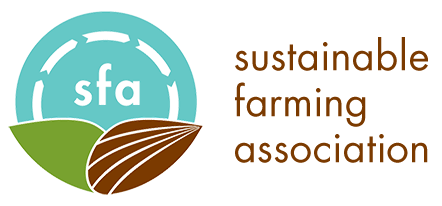Build farm resilience when you Give to the Max
My name is Jared Luhman, Soil Health Lead for the Sustainable Farming Association, SFA member, and grazier in southeast Minnesota.
 2021 was a challenging year for farmers across the state.
2021 was a challenging year for farmers across the state.
With Covid increasing the demand for local meat along with shortages of processing and possibly the worst drought in decades, we were challenged. The thing that stood out to me during my travels and work across the state is that the farmers who focused on building sustainable and resilient farms and businesses fared better than many others during the many struggles the past 18 months have brought. Notice, I didn’t say they were immune, and this is not to say that 100 percent of the time their situation improved, but overall they were more resilient to many of these challenges.
On our farm, which has been practicing regenerative grazing management for decades, during what is usually a spring flush, grass grew at rates we typically see in the slower late summer months. However, it still grew when many neighboring pastures did not. Using management practices we teach at SFA’s many farm field days, pasture walks, and one-on-one consultations, we slowed our rotation down, allowing grass to get more mature and put down deeper roots.
We also timed rotations to leave more residue on the soil. When the rains did come, our pastures were ready to take advantage of every drop. They responded immediately, growing as fast as on an average spring flush. Now we have thick, dense stands of diverse pasture mixes which will give us plenty of feed going into fall and winter.

SFA held two dozen educational events in 2021, reaching over 400 farmers.
This is not a unique story. I have seen similar results on farms across the state that I’ve had the opportunity to visit. Two farmers who had learned about bale grazing through an SFA field day or farm consult saw fantastic results, realizing that some of the only green and growing grass on their farm this summer was where the bale grazing had been. Another farm wanted to implement the soil health principle of increasing diversity by adding a small grain into their cropping rotation underseeded with clover. This clover was additional feed in the fall of a year when extra feed was an extremely valuable commodity. These are just a couple of the examples of SFA’s work resulting in farm resilience despite severe weather challenges.
SFA has also worked to develop alternatives to the status quo commodity food system. We’ve had the opportunity to work with individuals on building direct-marketing enterprises, adding value to products they are already producing. Members of our staff sit on a committee working to increase rural Minnesota’s processing capacity and to generate opportunities for new people to come into this space. By generating new and diverse marketing streams for our members we are helping them build a more resilient business model that’s less susceptible to disruptions caused by changes in the commodity market.
The work SFA does to change the agricultural industry is essential! We provide education, networking, and one-on-one consulting opportunities, working with farms of all shapes and sizes and any level of experience, with the goal of building regenerative and resilient farms and businesses across the state. Your Give to the Max gift will support this work, and enable us to reach even more farmers in 2022.
Please consider giving today to help us reach our goal of $10,000 by the end of Give to the Max Day (Thursday)! You can give on our GiveMN page or on our website. All donations will be honored with an annual membership to SFA.

